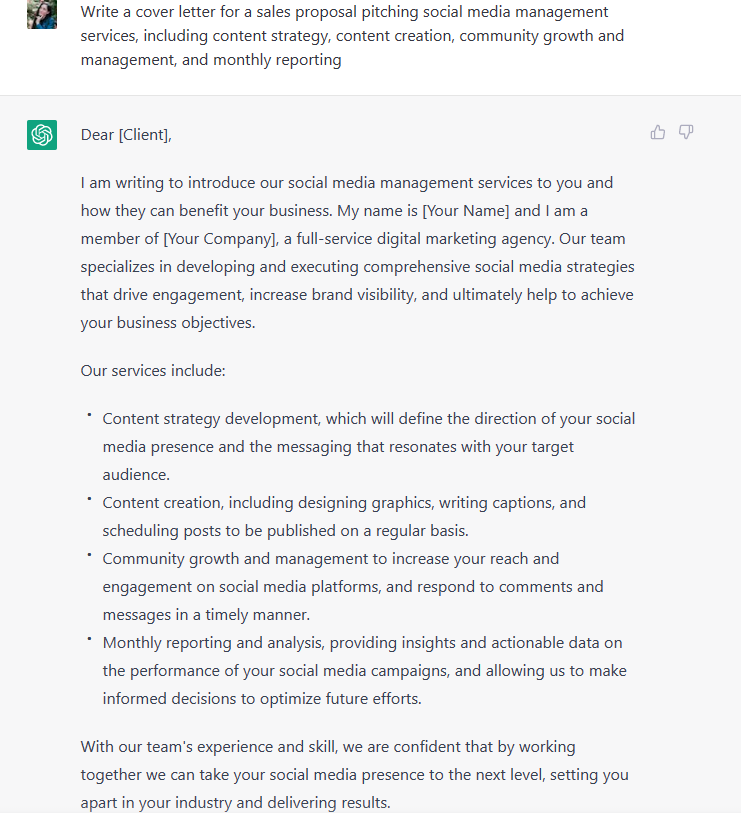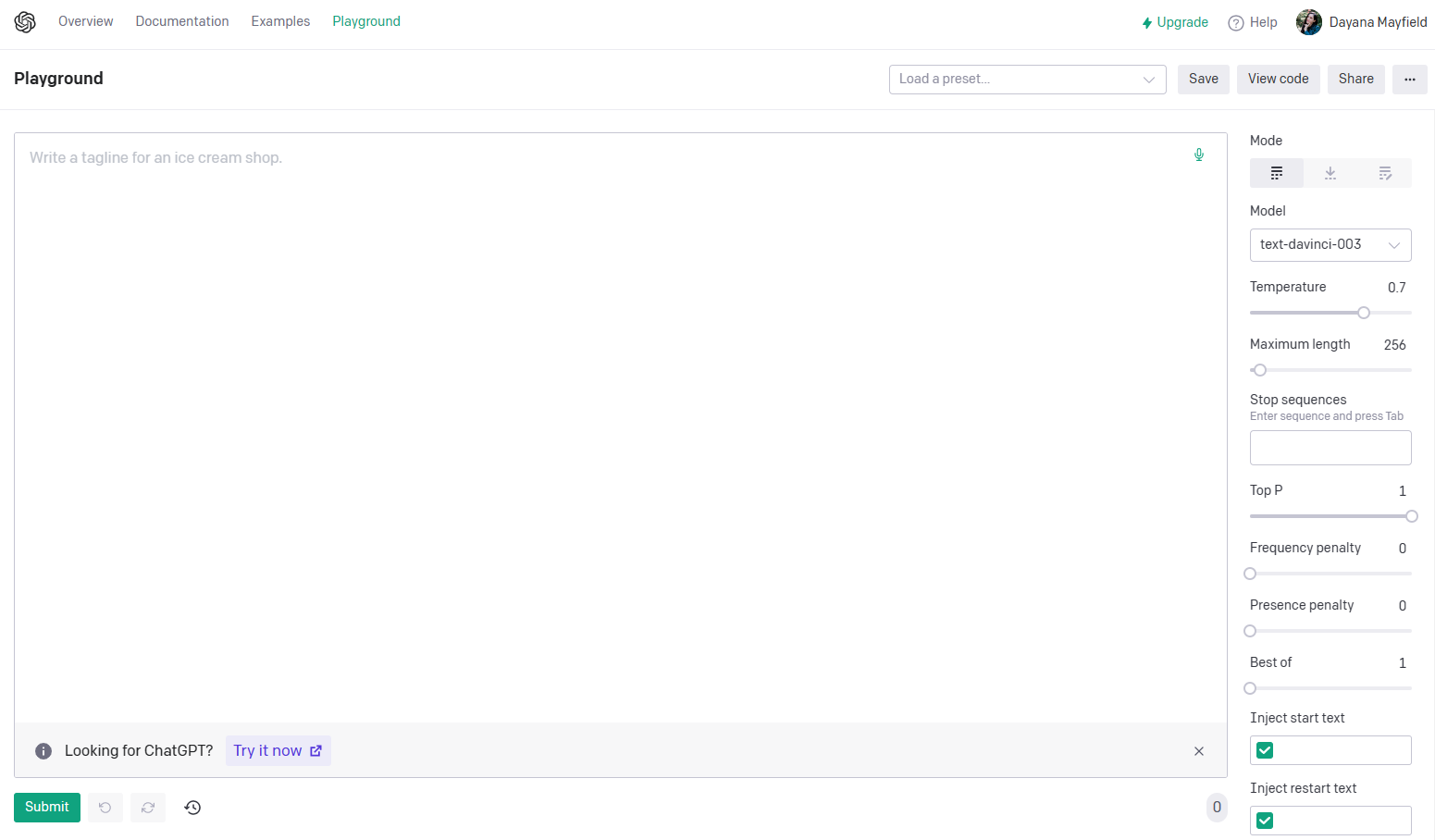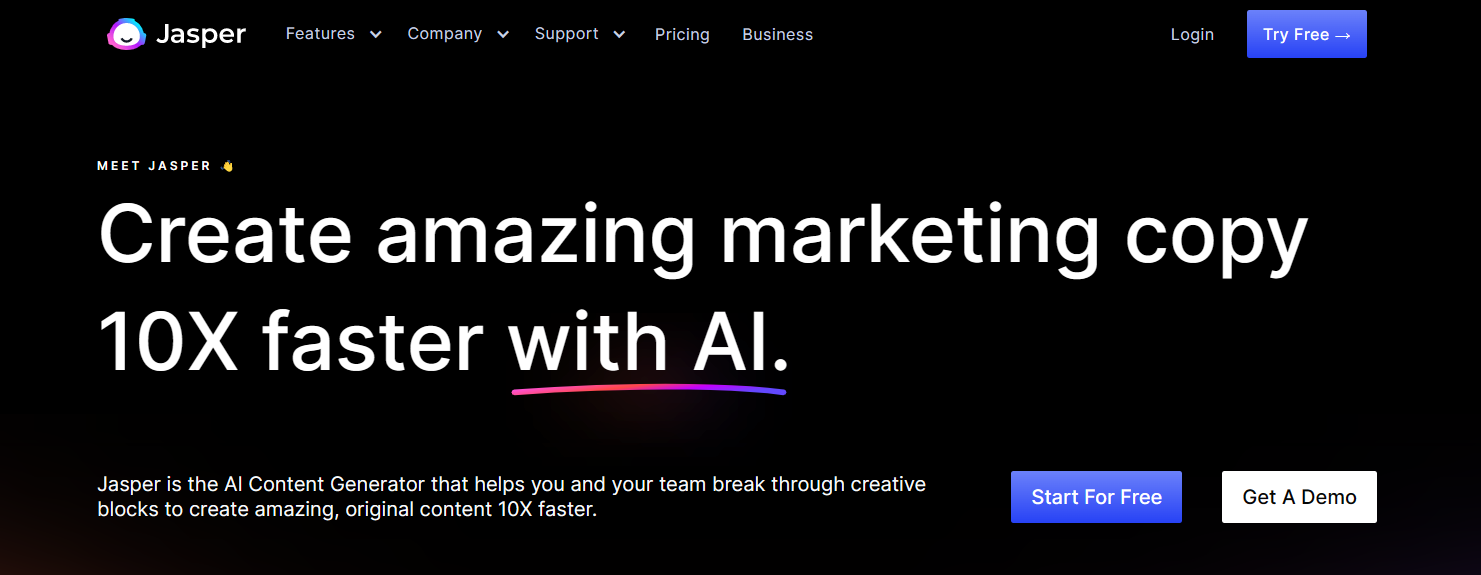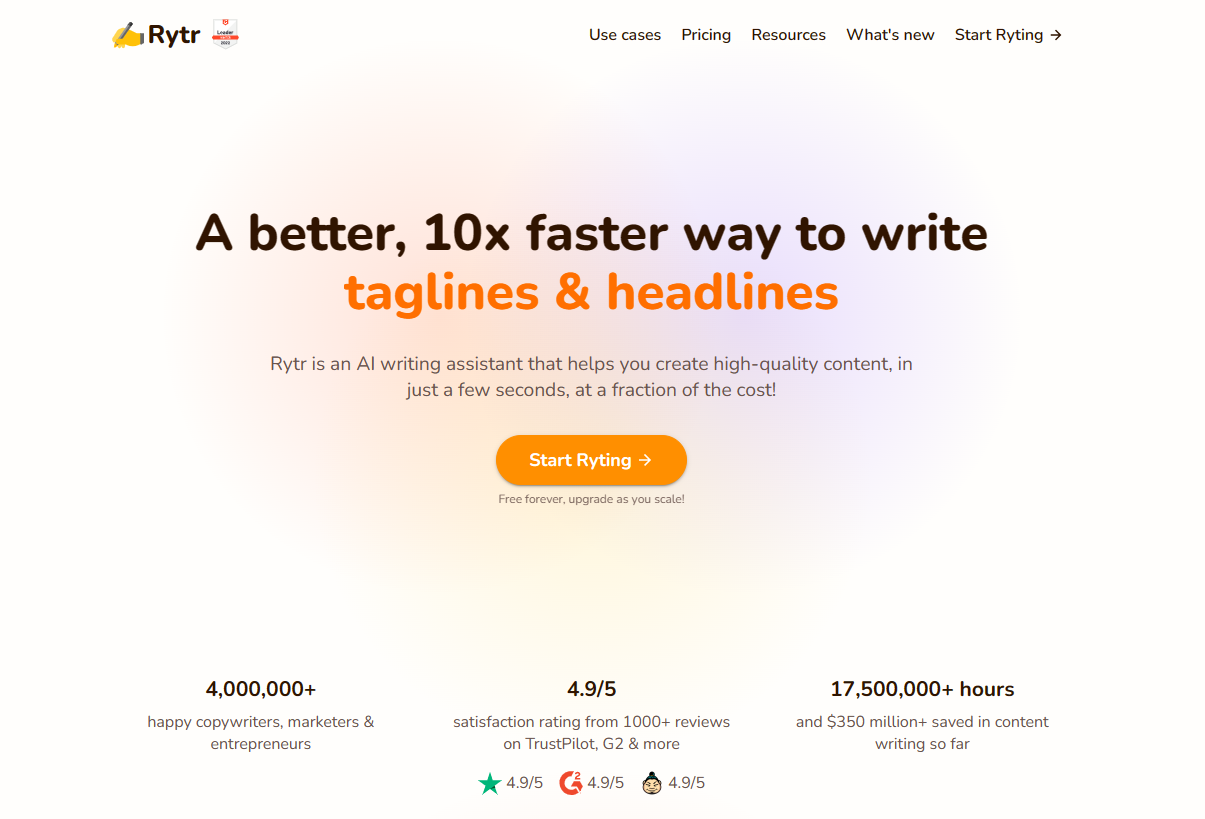7 Ways to Use AI for Proposal Writing
Published: January 16, 2023Updated: May 2, 2025

Marketers, sales professionals, and business leaders are all talking about the power of generative AI.
AI writing assistants are already being used to craft blog post headlines, outlines, and even paragraphs.
But what about proposals?
Is it possible to use AI to create a better proposal in less time?
We ran some experiments to find out how AI can help you write a proposal today—not guesses about the future (though we have some of those too).
Keep reading for our favorite ways to use AI as a proposal writer, pitfalls to watch out for, and free and affordable AI tools.
What’s in this guide:
- Can AI help with proposal writing?
-
7 ways to use AI to write a proposal
-
The best AI tools for proposal writing
-
The pros, cons, and future of AI writing
Can you use AI for proposal writing?
Short answer:
Yes. But, starting with a template is a better overall time saver.
Long answer:
How much value you get from AI will depend on your writing style and whether or not you already have a proposal template that works well for your business.
If you like bouncing ideas off of someone, you’ll enjoy having an AI writing assistant to help you get unstuck. But if you hate editing AI outputs, or would rather write from scratch, you won’t get a lot of value out of it.
To truly discover whether or not AI will help you, you need to experiment with it yourself.
Here are some signs that AI might be worth your time:
-
You hate staring at a blank page
-
You prefer editing over writing from scratch
-
You wish you had a writing buddy
-
You want fresh ideas for what to include in your proposal
Keep in mind that writing a proposal isn’t like writing a blog post (a common use case for AI), or using an AI subtitle generator for your video scripts. Unlike blogs that need constant fresh content, proposals usually have consistent messaging. Any customization is on a per-client basis, meaning your human inputs are invaluable. Proposals also require a lot more formatting and design work. This is why a great template is a better resource than an AI writer, so make sure you start there.
Choose from our 75 business proposal templates.
7 ways to use AI to write a proposal
There’s a lot of commotion over how quickly AI will progress and whether or not it will improve stylistically.
The future of writing AI is uncertain. All we know for sure is what it can do today.
Here are 7 ways you can actually use AI to help with your next proposal:
1. Generate a rough draft for a cover letter or specific section
One of the most popular ways to use an AI writing assistant is to generate a rough draft. As the saying goes, a crappy rough draft is better than nothing.
Even a bad rough draft gives you a starting point. It can spur you into action, prompting you to remove superfluous lines and giving you ideas for what to add instead.
I used ChatGPT to create a rough draft of a cover letter for a sales proposal pitching social media management.
Here’s the prompt and output:

It’s a little too formal and wordy for my taste, but the bullet-point descriptions are pretty detailed. It would be easy to keep those bullet-point descriptions and then shorten the intro and closing paragraph.
The next time you need to write a cover letter—or any other proposal section—try starting with AI. For your prompt, make sure you clarify:
-
the output (cover letter)
-
the context (proposal)
-
what to include (quick description of your social media management services)
2. Rewrite content from a public-use proposal template
You can also use AI to rewrite proposal paragraphs and snippets.
Maybe you want to take one of our proposal templates and make it fit your style a bit better.
Many AI writing tools offer some sort of rewrite function, where you paste in a paragraph and get a slightly modified version back.
For this example, I’ve used Peppertype.ai.
This is the original text from our investment proposal template: “We'll start by evaluating your current investment portfolio and financial planning. We'll talk about your goals, priorities, and dreams and choose a path that will get you there while optimizing your current financial picture.”
And here are the outputs:

As you can see, what the AI delivers isn’t that different from the original. Make sure you only employ this strategy with proposal content you have a legal right to use. Otherwise, you could run into plagiarism issues.
3. Customize your internal-use proposal template for a new client
You can also use AI to customize your own proposal template for a specific client.
For instance, let’s say you have a section called “Our Approach” or “Our Process.” Maybe you want to customize this to the prospect’s industry, core pain points, desired goals, or something else.
For this example, I used ChatGPT to slightly customize a section from our branding proposal template for the health and wellness industry.

ChatGPT came back with some text that was longer and had two mentions of “health and wellness.”
For now, your human ability to customize the text for a specific prospective client will probably outsmart that of any AI. But it’s worth playing around with if you’re experiencing writer’s block.
4. Brainstorm points to hit on in your proposal
While everyone disagrees on how good AI is at writing, most professionals do agree that it’s good at generating ideas.
Maybe you’re writing a proposal for a new service and you want to make sure you cover all of your bases.
Or maybe you’ve been sending the same proposal for a year and you want to add more detailed information and see if that increases your closing rate.
Whatever your motivation, you can absolutely use AI to give you ideas of what to include.
I used OpenAI’s Playground to come up with a list of 10 items to include in a proposal for bookkeeping services.
It came back with an excellent checklist.

Come up with your own list of what to include (based on your industry and service). You can use this to make sure you’re covering everything a client would want to know.
5. Come up with titles for your proposal sections
AI is also helpful for generating titles. You might use it to come up with a title for your entire proposal, or to rename specific sections.
Here, I’ve asked ChatGPT to generate different title ideas for the approach section of a proposal.

The outputs are clear and readily understandable—which is good because you don’t want to confuse your client.
If you want to freshen up your proposal and make it match your company’s style a little better, it can be really helpful to generate different titles. Then you can choose the best ones to add a custom feel to your proposal and help it stand out from the rest.
6. Write case studies
This is an advanced use case. AI writing tools don’t yet shine at writing case studies, so you’ll need to do a lot of editing. But you can use this function if you’d rather have something to edit than write from scratch.
Here, I’ve used Writer’s case study tool to input the challenge, solution, and results.
The AI spits out a case study with different headings, including a testimonial from a made-up person.

You can then adapt this to your needs.
For proposals, case studies are best kept short. So, try taking the best sentence or two from each section to make a one-paragraph case study.
7. Write detailed bullet-point lists
Proposals and bullet-point lists go together like peanut butter and jelly. You can use bullet-point lists in your cover letter, approach, deliverables, and more.
For this example, I’ve asked ChatGPT to come up with a list of things included in a market research service.
The list is clear and comprehensive.

Try it for your own offerings and remove whatever doesn’t fit.
You never know…you might just end up adding something to your service because it sounds so good.
[Bonus] Write emails for sending and following up
When you write a proposal, you also need to write emails to deliver the proposal and follow up.
So, we’ve included a bonus use case! You can use AI to write those emails.
This can be helpful for phrasing follow-ups in different ways (so you’ve got a longer follow-up sequence) and for simply saving time.
For this example, I asked OpenAI’s Playground to write a follow-up email for a project that could kick off on March 1.

The more details you give the AI, the better your output will be. So try adding details like what action you want the person to take, the date of the project kick off, etc.
The best AI tools for proposal writing
Are you curious about AI but not sure where to start? Try these free and affordable options.
1. OpenAI ChatGPT

ChatGPT is the open-source AI that the whole internet is talking about. As an open-source tool, it’s free to use. It’s become popular quickly because it offers higher quality outputs than most paid tools.
2. OpenAI Playground

Playground is a more advanced version of ChatGPT because you can play around with the rules for the tokens (strings of text). You can set the maximum token length, change the model to insert text in an existing paragraph, and more.
3. Jasper

Jasper is probably the most popular paid AI writing assistant. The lowest-cost plan costs $24 per month and gives you access to dozens of writing functions.
4. Writer

Writer is an enterprise-grade tool that allows you to train its AI in your writing style, brand voice, and publication guidelines (on its top-tier plan).
5. Rytr

With its free and low-priced paid plans, Rytr is a good alternative to Jasper. It offers content rewriting, headline ideas, a bullet-point generator, and more.
The pros, cons, and limitations of AI writing
Is AI worth using? Where is AI headed in the future? Let’s dig in.
What AI is good at
At this point in time, AI writing assistants are great at generating ideas, headlines, titles, and bullet-point lists.
It’s also good for eliminating the blank page and giving yourself a starting point. Even if the output is bad, that can inspire you to make it better and get your writing done quicker than if you had started from scratch.
If you’re in a very traditional industry, the formal writing style of AI might suit your needs just fine.
The downsides of using AI for proposal writing
AI writing can be prone to plagiarism and inaccuracy, because it uses machine learning to crawl the internet and piece together words that are related.
So you’ll need to vet and edit the outputs heavily.
As a seller, your knowledge of your prospect’s needs and goals is the most valuable thing you could put in your proposal.
By the time you prompt an AI writer with all this information and edit the outputs, you might find that it would’ve been faster to just do it yourself.
How to work within the limitations of AI
Don’t expect AI to write your whole proposal. Instead, think of it like a writing buddy to bounce ideas off of and help you when you get stuck.
Make sure you’re using a plagiarism checker, such as the one offered by Grammarly. Run your text through and make sure nothing was taken word for word from another source.
Use the idea-generating nature of AI to your advantage. Come up with lists of things to include in your pitch so you create a proposal that is super detailed and ready to close.
AI improvements we hope to see in the future
At this point in time, AI-generated text still sounds a little clunky.
We hope it gets better at creating content that’s more natural and simple.
We also hope that the ability to train AI in your unique writing style, business details, and point of view becomes widely available (so you don’t have to write complex prompts every time). And this will probably happen relatively soon, so keep your eye out for advancements.

Dayana Mayfield is a B2B SaaS copywriter who believes in the power of content marketing and a good smoothie. She lives in Northern California. Connect with her on LinkedIn here: linkedin.com/in/dayanamayfield/


